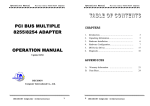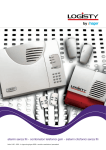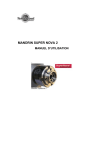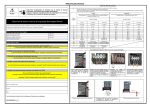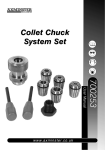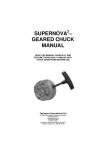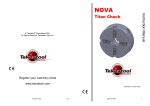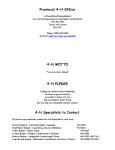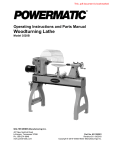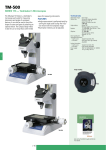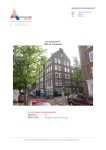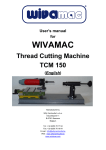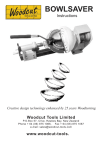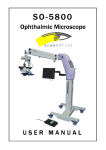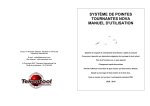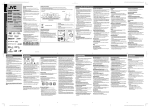Download Nova Scroll Chuck Manual
Transcript
Nova Scroll Chuck Manual READ THIS MANUAL CAREFULLY AND BECOME THOROUGHLY FAMILIAR WITH CHUCK OPERATIONS BEFORE USE Teknatool International Ltd 65 The Concourse, Henderson, Auckland, New Zealand Website: www.teknatool.com Email: [email protected] Phone: 0064-9-837 6900 Fax: 0064-9-837 6901 © Copyright Teknatool International 2000, 2003 Teknatool Publication No. 95-0324-005 Thank you for purchasing our Teknatool ova Scroll Chuck. We are confident it will help to enhance and advance your woodturning. The Teknatool Nova Scroll chuck is a very versatile unit, designed to offer a wide range of workholding modes. The Nova has a powerful grip while being quick and easy to use. It combines the best features of present woodturning chucks with the advantages of engineering scroll chucks - wide jaw movement, quick action and powerful grip in either the contraction or expansion mode. The Nova also has some special features such as a travel stop on the jaw and a unique action adjustment on the scroll movement. (N.Z. Patent Pending No. 244229). The basic Nova Chuck is equipped with a set of general purpose 50mm add on dovetail/spigot jaws. These jaws are designed to expand into recesses or contract around round/square wood spigots. Some irregular pieces can also be gripped. The chuck can swap from the expansion/dovetail mode to the spigot mode and back, instantly with no adjustments or extra fittings being necessary. In both modes, any spigot or recess size can be selected between the minimum and maximum range of the jaws. With the 50mm jaws removed, the jaw slides can be used to grip quite small spigots. The chuck is also supplied with a powerful Woodworm screw, for screw chuck work. The Nova Chuck is very adaptable and is designed to accept a range of accessories to further extend its use. Some of these accessories are included at the back of the manual. As a valued customer, we would be pleased to hear from you on how you found your Nova chuck. Any comments on the chuck or accessory ideas would be very welcome so that we can continue to offer what we believe is the best woodturning chucking system available. Accuracy: The Nova Chucks are sample tested from each batch and are made to run within the following tolerance limits: Face Runout Maximum: 0.1mm turn (0.0039 inch) Radial Runout Maximum: 0.13mm Brunt (0.005 inch) The testing is performed with the chuck mounted on a standard insert. To ensure accuracy when mounted on a Lathe refer to Page 6. It is well to note that wood is quite a plastic material - with different densities even in the same piece, and liable to warp out of place while turning. This is part of the beauty and appeal of working with such a medium. However, under these circumstances pursuing accuracies as quoted above can be very difficult to achieve. For most woodturning situations (with some exceptions) there is little need to achieve such tolerances. CONTENTS INTRODUCTION SAFETY RULES CHUCK OPERATION NOVA CHUCK EXPLODED ILLUSTRATION MOUNTING CHUCK ON LATHE ACTION ADJUSTMENT MAINTENANCE, STOP ON JAW TRAVEL, JAW SLIDES, INSERTION OF JAW SLIDES MOUNTING 50mm JAWS, OPERATING MODES DOVETAIL OPERATION, FORMING RECESS SPIGOT OPERATION OPTIONAL ACCESSORIES - JS25N, JS75N - JSCOLE - JSI00N WARRANTY TROUBLE SHOOTING GUIDE 2 PAGE 2 3 4 5 6 7 8 9 10 11 12 13 14 14 15 SAFETY DANGER: THIS CHUCK IS CAPABLE OF CONTRIBUTING TO SERIOUS INJURY, AS WITH ANY OTHER POWER TOOL ACCESSORY, IF USED IMPROPERLY ON THE LATHE. Before using the Nova Chuck, read and understand this instruction manual. Read and understand also the Lathe owner’s manual. If you do not have a manual, contact the supplier of your lathe to obtain one before using the lathe and chuck. User must be professionally trained to use this chuck. Vocational school courses are recommended. As with other chucking methods, an extremely cautious and sensible approach is necessary. With the Nova Chuck it is not possible to give exact directions as to the amount of tightening pressure required for workholding. Follow closely strict guidelines in this manual for different jaw types on wood blank diameters and length, plus turning speed. BEFORE USING NOVA CHUCK MAKE SURE THAT • ALWAYS WEAR EYE PROTECTION WHICH COMPLIES WITH CURRENT ANSI STANDARD Z87.1 (USA). WE RECOMMEND THAT A FULL FACE SHIELD IS USED AT ALL TIMES. • Chuck is properly secured on lathe spindle, Follow mounting instructions for your lathe for faceplates and other spindle fixtures. • For safety, DO NOT ROTATE CHUCK UNDER POWER WITHOUT WOOD BEING GRIPPED. • WARNING: EXCESSIVE SPEED IS A SERIOUS LATHE HAZARD. ALWAYS TURN AT THE SLOWEST SPEED POSSIBLE. Speed will vary with wood blank size. The larger the blank the slower the speed. Consult your lathe manual or lathe information plate for speed guidelines. DO NOT ATTEMPT TO USE THE CHUCK UNLESS THE LATHE SPEEDS ARE KNOWN. YOU MUST STRICTLY FOLLOW THE MAXIMUM SPEED LIMITS SET OUT IN THE OPERATING SECTION OF THIS MANUAL. DO NOT EXCEED THEM UNDER ANY CIRCUMSTANCES. • EXAMINE WOOD CAREFULLY. ONLY MOUNT WOOD THAT IS SOUND. If any cracks, splits, or weakness is found in wood - DO NOT MOUNT IN CHUCK. DO NOT MOUNT ANY WOOD THAT IS LIKELY TO BREAK UP DURING TURNING (E.G. ROTTEN OR SPONGY WOOD). DO NOT USE POORLY JOINTED LAMINATED WOOD. • Use levers to clamp wood firmly. Follow mounting instructions for different gripping modes and jaw types. In the expansion mode do not use undue force or jaws may split the wood. • Do not exceed maximum guidelines in this manual for wood blank diameters/length set out in this manual for the different modes and jaw types. • Check wood is securely held in chuck, before operation. Check grip by vigorously wrenching wood blank back and forth. If any loosening occurs, re-examine holding area for adequate grip (following mounting guidelines) and any damage to holding area. Rotate manually to make sure of clearance before switching power on. WARNING FOR SAFE OPERATION, DO NOT EXTEND JAW SLIDES BEYOND CHUCK BODY UNDER ANY CIRCUMSTANCES. ONLY OPERATE CHUCK WITH JAW SLIDE STOP SCREW IN PLACE. This prevents jaw slides from dislodging from chuck. Irregular or out of balance stock needs to be turned at the slowest possible speed until it is in balance. For use on outboard/ lefthand rotation - MAKE SURE INSERT IS SECURELY LOCKED WITH GRUBSCREW BEFORE USE. 3 SAFETY continued • Use only hand held woodturning chisels to shape wood being held in chuck. USE THE RIGHT CHISEL FOR THE JOB AND DO NOT FORCE TOOLS. Use safe and commonly approved chisel techniques. • Wherever possible stand to one side of revolving wood. • WEAR PROPER CLOTHING. Do not wear any loose clothing, neck ties, gloves, bracelets, rings or other jewellery that could get caught in moving parts. Wear protective hair covering to contain long hair. • DRUGS, ALCOHOL, MEDICATION. Do not operate chuck or lathe while under the influence of drugs, alcohol or any medication. • KEEP CHILDREN AND VISITORS AWAY. All children and visitors should be kept a safe distance from the work area. • MAKE WORKSHOP CHILDPROOF - with padlocks, master switches, or by removing starter keys. CHUCK OPERATION DIAGRAM A Adjustments: one lever (for the scroll action) and one handle (for the chuck body) are provided for adjustment of chuck action. Please refer to diagram (page 5) for location of lever and handle positions. If there is a spindle lock provided on your lathe (as with the Teknatool TL1OOO/8s) the scroll which operates the jaw movement can be rotated with only the scroll lever in place, the lever in the body position being unnecessary. Caution: release spindle lock after adjustment!!! Where a spindle lock is not provided both the scroll lever and the body handle must be used. One is located in the chuck body and one in the scroll ring (see diagram, page 5). Hold the chuck firmly in place and rotate the lever in the scroll ring to activate jaw DIAGRAM Bi movement. DIAGRAM B Lever and handle movement: (Chuck facing you or standing on the left hand side of the lathe in normal position). TO CONTRACT JAWS: Refer to diagram A. Put handle in body hole positioned towards the top and with handle facing you. Put the scroll lever in position at the top and slightly away from you. Hold the body handle stationary and move the scroll lever in a clock-wise direction away from you. This will close the jaws. Take out the scroll lever, reposition in next hole and repeat action until required movement is achieved. To obtain a little faster action the body handle can at the same time (as moving the scroll ring) be pushed down rotating the body in an anti-clockwise direction towards you. When the action takes up against the piece held give an extra nip up so jaws securely engage with wood. TO EXPAND JAWS: Refer to diagram B. Put handle in body hole positioned underneath chuck with handle faced towards you for ease of grip. Put the scroll lever in position at the top and slightly towards you. Hold the body handle stationary and move the scroll lever towards you. This will expand the jaws. To obtain a little faster action the body handle can at the same time (as moving the scroll ring) be pulled up towards you rotating the body in a clockwise direction. When the action takes up against the piece held give an extra nip up so jaws securely engage with wood. Using the scroll lever only with the chuck mounted on the spindle and the lever inserted in the scroll ring position. Starting from the top position when you pull lever towards you that will expand jaws. When pushed away it will contract jaws. 4 Circlip Scroll Operating Lever (3 positions) Scroll Ring Action Adjustment 6mm Screw (Use 3mm Allen Key) *NOTE: There is no insert for Nova Chucks with larger threads (over 28mm) as the thread is directly cut into chuck body. Insert Fibre Washer Use 1 1/2” Hex Spanner to wind insert. (Spanner NOT included). Fastening Kit - Please check contents: 1 x Scroll Operating Lever, 1 x Knob for Operating Lever (for convenience this may be glued to lever), 1 x body handle (this may be included separately in box), 1 x 4mm Allen Key, 1 x 3mm Allen Key, 8 x M6 x 10 Countersunk Screws, 1 x M6x6 grubscrew (secures insert), 1 x M6 x 6 grubscrew (for action adjustment), 1 x fibre washer (insert grubscrew), 1 x fibre washer (action adjustment grubscrew), 1 x M4 screw (or countersunk screw) for jaw slide travel lock (this may already be screwed into position on chuck body), 1 x woodworm screw RH. Standard Chuck Includes: Assembled Body, Scroll and Jaw Slides, Set of 50mm Add on jaws (4 segments). Manual, Fastening Kit. 3mm Allen 6mm Grub Screw (Insert Lock) key Fibre Washer 50mm Jaw Segment screwed in position on Jaw Slide Body Handle Jaw Slide Jaws Travel Stop (Standard Insert Type)* NOVA CHUCK 50mm Jaw Segment Indicates No. 1 Jaw slide position Chuck Body Jaw Shoulder see Caution Page 10 M6 x 10 Countersunk Retaining Screws Manufacturer’s Batch No./Letter Woodworm Screw RH 4mm Allen Key (for M6 x 10 Screws) 5 MOUNTING CHUCK ON LATHE There are two versions of the Nova Chuck: an insert version for all threads up to 27mm (1 1/8”) and a larger body version for dedicated threads up to 38mm (1 1/2”). CORRECT MOUNTING OF CHUCK TO INSERT (WITH INSERT VERSION) AND LATHE SPINDLE IS VERY IMPORTANT TO ACHIEVE ACCURACY. INSERT VERSION: Check that the correct insert has been supplied to match your lathe spindle thread. The code of the insert is on a label on the plastic insert cover and stamped on one of the flats of the hexagon section of the insert. A list of thread sizes that can be fitted with an insert plus the larger dedicated threads is provided opposite. If you find your lathe thread is not listed check with your supplier to see if there have been more recent additions to the thread range. Failing that, you may have to have a blank insert or blank chuck machined to your requirements at your own expense. WE STRONGLY RECOMMEND THAT THE CHUCK IS NOT USED ON LATHE SPINDLES UNDER 16mm (5/8”). FITTING TO CHUCK: Check that the internal spigot of chuck body plus insert threads are clean and that the spigot end of the insert is free from damage. Any dents or nicks must be carefully filed off so the insert can be fully screwed home in chuck body. Refer to diagram opposite. The tolerances of chuck body and insert area tight fit to ensure accuracy. This means that the insert may be difficult at first to engage with the chuck body thread. One way is to grip the chuck body in a vice (pad against damage) and screw in insert using a 1 1/2” AF spanner. Another method is to lay the chuck down flat on a bench and use the Nova operating lever or handle in the most convenient body position to prevent chuck movement while the insert is screwed in with the other hand. Care needs to be taken that the outer male insert thread is engaged property at the start with the female body thread. Screw insert fully home, making sure there is no gap between the face of the insert and the face of the internal body recess. This is important to ensure accurate running. Refer to diagram. Insert can now be locked to chuck body by means o f the M6x6 grubscrew provided. Make sure that the fibre/brass washer is inserted first to act as a buffer between the grubscrew and insert thread. DO NOT SCREW IN GRUBSCREW BEFORE INSERT IS SCREWED HOME IN CHUCK. IMPORTANT: LH THREAD INSERTS MUST BE LOCKED TO CHUCK BODY OR CHUCK BODY COULD UNWIND FROM INSERT. FITTING CHUCK TO LATHE: Correct fitting of chuck to lathe spindle is important to ensure accuracy. The chuck body must contact an accurate shoulder on the lathe spindle or bearings (as on Teknatool TI.1000) to ensure chuck will run true. There can be a wide variety of lathe spindle thread and spigot dimensions even within the same thread size. The internal thread size is kept to standard tolerances. The internal thread length and spigots of Nova inserts are manufactured to cover as wide a range of variations as possible. This will mean that in most situations you should be able to get a satisfactory match. CHECK THE FOLLOWING: Although the insert may screw on part way it may not contact properly with spindle spigot - a spacer or some further modification of the insert may be necessary. This would be the responsibility of the chuck user. Make sure the chuck is screwed to lathe thread properly -a good check is to see whether it screws home on the spindle the same as another lathe fixture such as a faceplate. POOR FIT OF CHUCK TO LATHE SPINDLE CREATES A SERIOUS HAZARD WHERE CHUCK COULD DISLODGE FROM LATHE. DO NOT ATTEMPT TO USE CHUCK UNLESS THE CHUCK US CORRECTLY FITTED TO LATHE SPINDLE. 6 Threads covered by the Insert System (Threads up to 28mm (1 1/8 inch) Insert Insert Insert Insert Insert Insert Insert Insert Insert Insert Insert Insert Insert Insert Insert 2 3 6 7 8 A B C D E F H I J L (I2NS) (I3NS) (I6NS) (I7NS) (I8NS) (IANS) (IBNS) (ICNS) (IDNS) (IENS) (IFNS) (IHNS) (HNS) (IJNS) (ILNS) : : : : : : : : : : : : : : : Insert Insert Insert Insert Insert Insert Insert Insert K M N O T U V W (IKNS) (IMNS) (INNS) (IONS) (ITNS) (IUNS) (IVNS) (IWNS) : : : : : : : : M20 x 2 Tyme Cub M20 x 1.5 Electra Beckum Multico Sumaro 3/4” Plain Bore 1 1/8” 8 TPI UN RH 7/8” 12TPI NS LH 3/4” 14TPI BSP RH Teknatool (Pre 1986) 3/4” 14TPI BSP LH Teknatool (Pre 1986) 1” 10TPI BSF RH Teknatool Woodfast Durden 1” 8TPI BSW RH General Rockwell Delta Golding 1” 12TPI RH Myford MLS 5/8” Plain Bore Shopsmith 3/4” 10TPI BSW RH Rockwell Homecraft M24 x 3 RH B Line, Arundel K600 K450 1 1/8” 12TPI RH Myford Mystro ILNS 1” UNS 8 TPI RH (for DVR lathes with this thread only) M18 x 2.5 ELU DB180 1” 1OTPI BSF LH Teknatool Woodfast Durden Blank. Can be thread up to 28mm 1/8” 1 1/8” BSW RH Morton 1” 8TPI UNC Dual Threaded LH and RH 1 1/8” UNF RH Taiwanese 7/8” 14TPI NF RH M25 x 2 RH Tyme Avon Body Internal Spindle Lathe Spindle Thread Direct to Chuck D Chuck (NSCD) 4 Chuck 5 Chuck P Chuck (NSB4) (NSC5) (NSBP) : 1” 8TPI BSW RH Note: Maximum spindle length 25.4mm : M33 x 3.5 : 3/4” 16TPI UNF 1/8” spigot : 1 1/2” BSW RH RTanner Union Graduate R Chuck X Chuck (NSBR) (NXBS) : Blank chuck for threads up to 30mm : 1 1/2” 8TPI NF Conover Check insert is fully home - NO gap On lathe must mate against accurate datum surface/shoulder NO Gap ACTION ADJUSTMENT The Nova Chuck has a unique built in action adjustment facility. (NZ Patent Pending Application No. 244229). Please refer to exploded view of the chuck, on Page 5. By means at the action adjustment the effort required to turn the scroll ring is adjustable. 1 . This will allow you to adjust the feel of the chuck more to your own requirements. 2. Adjust for wear over the life of the chuck. 3. An added feature of the action adjustment is that the movement can be effectively impeded for special turning requirements. IMPORTANT: THE ACTION ADJUSTMENT SHOULD NOT BE RELIED ON AS A MOVEMENT LOCK. Normal work mounting procedures and recommendations in this manual should be followed. The action adjustment is by means of grubscrew positioned in one o f the three lever hole positions on the scroll ring. The grubscrew pushes down on a fibre washer which bears against the inner chuck body. One of the M6 grubscrews (remember to act as a buffer) provided in the fastening kit needs to be screwed into the threaded hole at the bottom of one of the lever hole positions on the scroll ring. Note only one of the lower hole positions is threaded at the bottom. Screwing the grubscrew in (turning it clock-wise) will force the fibre washer against the inner body section. The more the grubscrew is screwed in, the tighter the chuck action will become. Conversely unscrewing the grubscrew will give a freer action. By use of this action adjustment feature, over time the action of the chuck can be adjusted. Only occasional adjustment of the grubscrew should be necessary. 7 MAINTENANCE CLEANING CHUCK: Inspect chuck periodically for buildup of wood dust inside scroll. Wood dust build up will make the jaws difficult to move. To clean out the wood dust build up, the following method can be used. Remove Jaw Slides. (First removing stop screw as explained in previous section); then using a piece of wood (match stick size) insert in the bottom of scroll and rotate scroll ring. This will scrape out build up of wood dust. To disassemble chuck: (Refer to exploded chuck diagram, Page 5). Use expanding circlip pliers to remove circlip securing scroll. The scroll can then be removed and the jaws slipped out of the chuck. Clean scroll and jaws with kerosene. Dry with cloth and lightly oil components. Do not over oil as this will cause a more rapid build up of wood dust again. After cleaning - to reassemble, replace scroll and secure with circlip. Re-insert jaw slides as per instructions. Remember to replace jaw travel stop screw. STOP ON JAW TRAVEL: Stop screw is located at the end of the number one slideway in the body section of the chuck. The screw prevents jaw slides being unwound from the chuck. Do not exert pressure against the screw with lever action. If screw is removed for disassembly it must be replaced before use. Refer exploded view diagram on page 5 of the manual, and to drawing accompanying insertion of jaw slides below. JAW SLIDES Caution: Do not close jaw slides to a diameter less than 8mm (5/16") for workholding. Do not close jaw slides to fully closed position because jaw slides could over travel on scroll and become disengaged. INSERTION OF JAW SLIDES Jaw slides are numbered 1 - 4 (numbering on end of slide). (Note: Travel stop screw at the end of No.1 body slide needs to be removed. Refer to previous jaw slide travel lock section). When the jaws are removed from the body they need to be reset in sequence. To reset jaws in chuck body, rotate until the lead o f the scroll (like a thin wedge) appears in the opening of the slide way with ‘1’ marked beside it. (For Nova chucks with ‘1’ not marked on chuck face, any slideway may be selected. See diagram below. CAUTION: IT IS IMPORTANT TO ROTATE THE LEADING EDGE OF THE SCROLL BACK SLIGHTLY TO CLEAR THE SLIDEWAY BEFORE SLIDE CAN BE INSERTED. FAILURE TO ROTATE THE SCROLL BACK COULD RESULT IN DAMAGE TO SCROLL. Now insert No. 1 slide into slideway and rotate scroll in a clockwise direction (chuck facing you) until the lead of the scroll appears at the next slideway. Now engage No. 2 scroll in the same manner as No. 1. Proceed in the same way in a clockwise sequence with No.3 and No.4 slides. Refer to the diagram. Lead of Scroll Travel Stop Screw Insert jaws in clockwise sequence 8 MOUNTING 50mm JAWS Your standard Nova Scroll chuck is provided with 50mm add-on jaws. They need to be located and screwed on to the jaw slides of the chuck. The same procedure outlined below must be followed for all accessory jaws as well. IT IS IMPORTANT TO LOCATE JAWS PROPERLY IN THE JAW SLIDES FOR THE CHUCK TO FUNCTION ACCURATELY. Follow the method set out below 1. You will notice that the back of the jaws have a stepped location ring. This location ring is designed to fit into the grooved section of the jaw slide for precision location. Ensure that the slide and collet back are clean and free from any burrs or damage that might affect location. Place the jaw segment over the hole positions on the jaw. Press the jaw segment firmly onto the jaw slide. For the first few times you may need to GENTLY tap the jaws into the locator slot with a block of wood. 2. The screws can now be screwed in, using the 4mm Allen key provided. Lightly grease or oil screws under each head and on the threads before use to prevent the screws from seizing in the jaw. Preferably use an anti-seize compound e.g. ROCOL J 166 Anti-Seize Compound. Do all screws up finger tight and then back them off one quarter to half a turn. 3. Wind the mounted jaws into the centre of the chuck until they all butt against the other. Now finally tighten screws, starting with centre screws and then outside screws. Nip screws up firmly but DO NOT OVERTIGHTEN. 4. Check there is no light between jaw slides and add on jaw segments or that one or more segments is not higher or lower than the rest. If this is the case repeat procedure above. In line with adjacent Jaws OPERATING MODES Flush with Jaw Slides SCREW CHUCK: This is a convenient mounting method. The woodworm screw is purposedesigned for screw chucking. It is a cylindrical screw which maintains its full holding power along the whole length, unlike normal tapered screws. The thin thread form is specially designed to cause minimum damage to wood fibres. They grip better than screws with thicker threads because there is a larger volume of undamaged wood retained within the screw. The woodworm screw is made complete with the boss section in one piece. The woodworm screw is designed to be used with the 50mm jaws remaining in place on the chuck. This facility is very convenient for remounting work directly onto the jaws after the screw is removed. To convert to this operation, place the boss section into the centre of the chuck making sure flat shanks are aligned to the jaw slides and close jaws around it. BEFORE FINAL TIGHTENING MAKE SURE THAT THE FRONT OF THE BOSS SECTION OF THE SCREW IS SEATED BEHIND AND AGAINST THE 50mm JAWS. This will prevent any tendency for the boss section to creep forward when the screw is being used. The front face of the 50mm jaws has been machined to provide an accurate backing surface. This is quite an advantage, providing a much tighter fit and better tolerance for irregular face stock. This feature is also quite an advantage when using the screw to mount a bowl for first stage bowl turning - forming the outside of the bowl straight onto the jaws (the screw is first removed) after the recess has been formed. SCREW DEPTH: The screw provides 19mm (314 inch) of thread beyond the 50mm jaws. With all wood blocks over 150mm (6 inches) in diameter the full thread depth of 19mm should be used. 9 CAPACITY: DO NOT USE THE SCREW FOR VERY LARGE WOOD BLANKS. Its use is intended for small bowl and screw chucking work. The maximum capacity which should be mounted on the screw 250mm (10 inches) diameter x 100mm (4 inches) DO NOT EXCEED 600 RPM FOR THIS OPERATION Use tailstock support where possible. PREPARATION: The 10.5mm thread requires a drilled hole about 7mm (9/32”) in diameter. For soft woods a 6.35mm (1/4”) drilled hole could be used. The screw has considerable holding power and it is sometimes difficult to unscrew, so wax or oil the thread before mounting the wood. CARE: The threads are fine and can be damaged by mishandling. DON'T hammer into wood! DO screw into a pre-drilled hole. Any nicks on the threads can be removed by careful filing. DOVETAIL OPERATION Expansion of the jaws into a recess. This function is for bowl and platter turning where the projection (depth) of the wood blank is not too great i.e. up to 100mm (4 inches). Characteristically these items have a parallel wood grain. IT MUST NOT BE USED FOR ANY LONG WORK (OVER 100mm) AS THERE WOULD BE GREAT DANGER OF WOOD TEARING OUT AND DISLODGING FROM CHUCK. Instructions below apply to the standard 50mm jaws but the general technique is the same with other accessory jaws. However the maximum size of wood blank that can be mounted, the maximum turning speed and recess size varies with the different accessory jaws. Consult specific instructions included for each jaw set. This is a strong holding method. Using the standard 50mm jaws bowls up to 3 10mm (12 inches) in diameter can be turned. DO NOT EXCEED 600 RPM WITH THIS OPERATION. OUT OF BALANCE STOCK MUST BE TURNED AT THE SLOWEST SPEED POSSIBLE. 50mm jaws: Any recess can be turned between 50mm (2 inches) and 75mm (3 inches) diameter. Choose the diameter which suits your bowl design. However, bear in mind that best workholding will be achieved around 50mm - keep your recesses between 50mm and 60mm where ever possible. Extra care must be taken while turning with recesses above 60mm. The depth of the dovetail recess can be varied according to the size and mass of the workpiece. The larger bowl blanks or softer woods will require a deeper recess up to the maximum of 6mm (1/4 inch). HOWEVER YOU MUST USE THE MAXIMUM RECESS DEPTH ON ALL RECESSES OVER 64mm (2.5 inches) diameter OR ANY WORK WITH A DIAMETER OVER 150mm (6 inches). For smaller lids and thin platters (not exceeding 150mm diameter) only a shallow recess of around 3mm (1/4 inch) is necessary. It will be a matter of gaining experience as to what combinations and sizes will suit best. FORMING RECESS The jaw dovetail has been designed for use with a standard skew scraper. This chisel will make a recess to the angle required. FOR SAFETY REASONS WE STRONGLY ADVISE AGAINST USING ANY OTHER TOOL. A profile of this chisel is shown opposite. It is best to work with a tool which is already ground to the correct angle. All that is necessary then is to keep the leading edge of the chisel flat on the wood, moving forward and out to form the recess to the required diameter and depth. Mount bowl blank on screw as described in previous section. It may be convenient to first mark out with a pencil, a circle on the bowl blank. To mark out the recess diameter with a pencil: hold pencil point to desired radius, supported on the toolrest. Then revolve blank by hand thus creating a pencilled circle. However, as specified above, any recess diameter can be made between 50mm (2 inches) - 75mm (3 inches) (standard 50mm jaws) so exact sizing of the recess is unnecessary. 10 This edge is kept against wood Bottom dished out Dovetail Chisel Dovetail Chisel 15˚ angle to suit dovetail Before scraping out the recess, slightly hollow out the centre of the bowl blank with a bowl gouge or round nose scraper. The purpose is to relieve the centre so that when the recess is scraped out only half the chisel edge needs to be used. We recommend this to reduce tearing of the wood by scraping action; and to make the recess a little more finished to give a better effect to the overall bowl. Extra embellishments can also be made to the recess to enhance the bowl. After the recess is finished and the outside of the bowl is turned to shape, wind bowl back off screw. Bowl blank is now ready to be reversed onto the jaws. Using the lever in the scroll, expand the jaws into the recess. When the jaws are expanded out into the recess, screw the wood blank gently back and forth to make sure it is seated properly on the bottom face of the jaws. WARNING: MAKE SURE THE JAWS ARE SEATED PROPERLY IN THE RECESS AND THAT THE BOWL IS NOT INCORRECTLY RIDING ON THE FLAT SHOULDER SECTION OF THE JAWS BEHIND THE DOVETAIL. THIS COULD LEAD TO THE BOWL DISLODGING FROM CHUCK. LOOSEN JAWS AND REMOUNT CORRECTLY. Now give a few gentle raps with the end of a chisel handle or wooden mallet around centre of bowl. Put body handle in position and using scroll lever and handle give an extra nip up. Refer to chuck operation on Page 4. Refer again to safety before operation. SPIGOT OPERATION This is where the jaws contract around a wooden spigot for grip. This function is mainly for box, goblet and vase turning, that is, endgrain items with a fair degree of overhang. This situation is one of the most difficult to provide secure holding no matter what fixing method is used. EXTREME CAUTION WITH THIS OPERATION MUST BE EXERCISED. DO NOT EXCEED 850 RPM FOR THIS OPERATION. If used properly the Nova chuck however, provides a very secure grip in this mode. Instructions below apply to the standard 50mm jaws but the general spigot technique is the same for other jaw types. However, maximum size of wood blank that can be mounted, maximum turning speed and recess size varies with different jaw types. Consult accessory jaw instruction sheet. With the standard set of 50mm jaws a maximum size wood blank of I 00mm (4 inches) diameter (NOT spigot size) by 150mm (6 inches) length can be turned. Square timber of same length and between 40mm (1.5 inches) to 50mm (2 inches) can be directly clamped in jaws. Irregular, rough tree blanks (e.g. small sections of tree limbs) not exceeding the above sizes can be held quite firmly BUT extreme caution must be exercised. Check for adequate contact and grip of all four jaws into wood. MAKE SURE YOU HAVE AN ADEQUATE GRIP BEFORE OPERATION by vigorously wrenching the limb mounted in the chuck. If any loosening occurs DO NOT PROCEED with operation. Repeat tightening procedure and retest grip. SPIGOT SIZE: Standard jaws will grip a round spigot between 45mm (149/64 inches) to 65mm (2 9/16 inches) approximately. Square timber between 40mm (1 37/64 inches) to 50mm square approximately. 11 Jaw slides only: With the 50mm add on jaws removed, the jaw slides will grip either round or square timber down to 8mm (5/16 inch). Length limits same for spigot work (Page 11). Small work not greater than this diameter can be turned at a speed NOT EXCEEDING 1800 RPM. Larger work held in the jaw slides should not exceed 850 RPM. FORMING SPIGOT: When selecting wood make sure it is sound without splits or weakness especially around the area where the spigot is to be formed. REMEMBER WITH FREE END TURNING THIS IS THE ONLY AREA OF GRIP. IF ANY WEAKNESS IS FOUND, DO NOT PROCEED. Mount wood between centres and turn the spigot area. Make the spigot as parallel as possible to maximise the efficiency of the clamping action. Only approximate sizing of the spigot is necessary as the jaws will accommodate a wide range of spigot diameters within the spigot limits stated above. The length of the spigot area for the standard jaw must not be less than 16mm (5/8 inch). The 50mm standard jaw has a thin lip or shoulder at the front face. This is designed to bite into the timber as the jaws are tightened. DO NOT CUT A RECESS FOR THE LIP TO FIT INTO AS THIS WILL REDUCE GRIPPING POWER. OPTIONAL ACCESSORIES Nova Chuck 25mm (1”) Jaw Set Code: JS25N This versatile 25mm jaw set is designed for a variety of small bowl (expanding dovetail) and small spigot (contracting mode), generally below the size that can be handled by the standard 50mm jaws. The 25mm jaw can also act as a type of pin chuck expanding the jaws into a 25mm bored hole for first bowl work. Nova Chuck Step Jaw Set Code: JS75N The step jaws are primarily to grip in the contracting mode, the base (foot) of footed bowls. The step sizes provide optimum gripping for three foot sizes, 42mm (1 21/32 inch), 51 mm (2 inches) and 64mm (2 33/64 inches). There is also an expanding dovetail mode for alternative recess gripping of bowls. 12 Nova Chuck Cole Jaw Set Code: JSCOLE REMOUNTING BOWLS The Cole Jaws are a very versatile set designed primarily for the re-chucking of bowls to remove chuck marks or to re-shape the bottom of bowls that have already been turned. There is also provision to mount the 50mm, Step and I 00mm jaws on to the Cole Jaws which enhances their use considerably. All the facilities of the other jaw sets can be fully utilised in conjunction with the Cole Jaws. These jaws more than any other really begin to explore the tremendous versatility of the Nova Chuck. A special woodworm screw (optional) can be used for initial bowl mounting. With this combination of holding methods it is possible to turn a bowl from a rough blank to a completely finished smooth bowl with just this one jaw set. The Nova Cole Jaw combination is the only chucking system to allow such a complete facility without any complex jaw changes or different set ups. There are a number of re-chucking options; false wooden jaws can be added, wooden dowels used, or rubber stoppers which are provided with the basic kit. OTHER ACCESSORIES: LH Woodworm for LH/Outboard screw chucking RH Woodworm screw for Cole Jaws Nova Chuck Fastening Kit Cole Jaw Fastening Kit (incl. rubbers) 100mm Jaw Fastening Kit A wide variety of new jaws and accessories will become available. Check with your dealer for release of new accessories. 13 Nova Chuck 100mm (4”) Jaw Set Code: JS100N The 100mm jaws are a innovative set designed for an expanded dovetail grip, reverse dovetail for gripping footed wooden bowls plus a spigot facility. This jaw has a deep external dovetail of 9mm (.35”) approx. An important function available is provision to mount false wooden jaws so customised jaws can be made for special purposes. WARRANTY DATE PURCHASED .................................................................. (To be completed by Sales Outlet). This Teknatool Product is backed by a warranty period of twenty four months from the date of purchase. Teknatool International hereby agrees to make repairs or replace components without charge for any defects due to faulty material or workmanship, provided that 1. The warranty period has not elapsed. Proof of purchase date (sales slip etc) would need to be forwarded to Teknatool International. 2. If in our opinion the unit has not been altered, repaired or modified in any way that would affect its operation; has not been subjected to misuse, negligence, accident or not used strictly in accordance with instructions. 3. Where necessary transportation is prepaid to Factory Service Centre, or other authorised Teknatool Service Centre. Warranty does not cover any costs or damages arising directly or indirectly from the operation of this Teknatool Product. No other guarantee, written or verbal is authorised by Teknatool International. OVERSEAS CUSTOMERS: Our Teknatool agents will issue their own Warranty to cover this product. The terms may very from those stated above - please check with your dealer. Our policy is one of continuous improvement. We therefore reserve the right to change specification/design without notice. 14 TROUBLE SHOOTING GUIDE FAULT REMEDY 1. Insert jams when partially threaded into body Check insert thread and chuck body thread are free from damage. Check insert has engaged with chuck body thread correctly. See ‘Fitting to Chuck’ Page 6. Make sure grubscrew has not been SCREWED IN. 2. Chuck body appears not to run true Check insert is property home in chuck body. Check that the insert is correctly screwed onto lathe spindle. Insert must back against accurate face/register or bearing on lathe spindle. See Page 7. 3. 50mm Add on jaws do not run true Check 50mm jaws are mounted correctly on jaw slides, For method see Page 9. For accuracy parameters see Page 2. When the jaws are expanded beyond a 50mm circle they will appear to be running out but in fact are maintaining concentricity. Always evaluate runout from turned wood clamped in jaws. 4. Jaw Slides closed to centre and No. I Slide stays in centre when jaws are expanded again Jaw slide(s) have overtravelled from scroll. It will be necessary to tap back No.1 jaw slide until it has re-engaged. See Page 8 for ‘insertion of jaws slides.’ 5. Chuck very stiff to operate or jammed See notes on chuck operation Page 4. Wood dust and shavings can clog the chuck in use. The chuck should be disassembled and cleaned. Follow instruction Page 4. Check grubscrew controlling action adjustment. 6. Jaw Slides when wound to centre do not meet Slides have not engaged sequentially in clockwise order with scroll - 12-3-4. Jaw slides could have been inserted out of order. Check insertion procedure Page 8. 7. When chuck is being removed from spindle the body unwinds from insert Either lock insert in body using grubscrew and fibre washer provided or use insert spanner on the insert to wind chuck off lathe. 8. Chuck jams on lathe spindle This is a common problem with fixtures on a lathe. To help prevent it try a plastic or fibre washer between insert/chuck and spigot shoulder of spindle. Greasing of insert face and spindle can also help - Note - Use of washer could affect accuracy. 9. Woodworm screw creeps forward or is not seated properly in chuck Make sure woodworm screw boss is placed correctly between jaw slides and behind 50mm jaws. See Page 9. 10. Wooden spigot shifts during turning Check that the spigot area is made correctly for jaws to grip. Check that the spigot is not oversize. See spigot operation instructions Page 11. Use careful chisel techniques that do not exert too much pressure. Irregular rough wood blanks need to be checked to see whether there is enough jaw contact. 11. Wood blank does not seat properly in internal dovetail mounting Check the angle of the dovetail recess made is the same angle as the jaws. Make sure the bottom of the recess is flat and square to face. See dovetail operation Page 10. Check that the bowl is not incorrectly riding on the flat shoulder of jaws behind the dovetail. 12. Wood blank appears jammed in chuck jaws Make sure you are using operating lever and handle in the correct sequence to release jaws. Practise jaw movement so you remember direction of release or contraction. Refer to lever and handle movement Page 4. 15 Teknatool International Ltd 65 The Concourse, Henderson, Auckland, New Zealand Phone: 0064-9-837 6900 Fax: 0064-9-837 6901
















